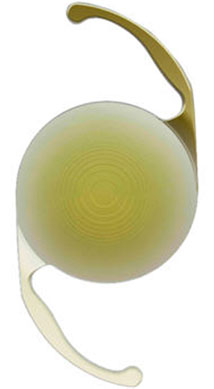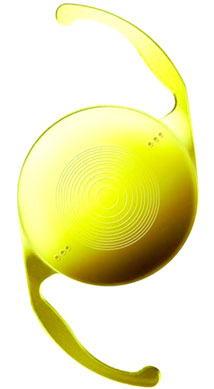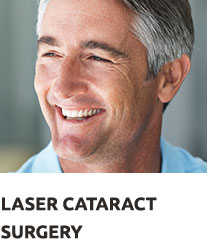Premium Lenses
During cataract surgery, artificial lenses are implanted in the eye to replace the cloudy natural lenses. These artificial lenses, known as intraocular lenses (IOLs), were once only able to correct distance vision, leaving patients dependent on eyeglasses or contact lenses for near vision.
Many cataract patients, in addition to suffering from either nearsightedness or farsightedness, also suffer from presbyopia, natural changes to the eyes that occur as we age. Before premium lenses, patients were unable to see clearly at both near and far distances without the use of eyeglasses or contact lenses. Early lens implants were monofocal, meaning that they had only one focal point and could not adjust to varying distances.
New advances in technology have allowed for the development of multifocal IOLs, which let patients see clearly at all distances, and can even correct astigmatism as well. Premium lens implants are ideal for cataract patients who are also suffering from presbyopia and want a replacement lens that provides a full range of clear vision.
There are several different types of premium lens implants available for cataract patients. Your doctor will work with you to decide which lens is best for your individual eyes to help you enjoy long-lasting, clear vision at near, intermediate and far distances. To speak with one of our doctors and discuss your options for cataract replacement lenses, please call us today to schedule a consultation.
ReSTOR® Multi Focal IOL

Through recent advancements in lens technology, an IOL is now available that can provide the patient with a greater range of vision while reducing the need for glasses and contacts. The ReSTOR intraocular lens provides a full range of functional vision for patients that desire a significant decrease in their dependence on glasses or contacts.
Candidates for ReSTOR® Lenses
Anyone who is dependent on reading glasses or bifocals may be a candidate for ReSTOR implant surgery. Although ReSTOR lenses were originally designed for patients with cataracts, having cataracts is not necessary to qualify for the ReSTOR lens; you only need a desire to restore eyesight at a range of distances without corrective eyewear. People with chronic infections, uncontrolled diabetes, or other health problems may have to wait until these conditions are under control prior to surgery.
How ReSTOR® Works
ReSTOR, short for AcrySof® ReSTOR® Apodized Diffractive Optic Posterior Intraocular Lens, replaces the natural lens removed because of cataracts. It has a patented optic design that combines apodized diffraction and refraction technologies for quality vision at both near and far distances. The apodized diffractive optic design gives it the ability to focus light correctly on the retina for images at various distances without mechanical movement of the lens.
Apodization is the gradual reduction or blending of the diffractive steps from the center to the outside edge of a lens; it creates a smooth transition of light between the distant, intermediate, and near focal points. Diffraction involves the bending or spreading of light to multiple focal points as it passes through the lens. The center of the ReSTOR lens surface consists of an apodized diffractive optic. This means that the series of tiny steps in the center area work together to focus light for near through distant vision.
Refraction involves the redirection of light passing through the lens to focus on the retina. The refractive region of the ReSTOR lens bends light to a focal point on the retina. This outer region – surrounding the apodized diffraction center – focuses light for distant vision.
Toric IOLs

Up until now, patients with astigmatism did not have the same opportunities that other cataract patients have had in correcting their condition with the types of IOL lenses that were available. Typically, the astigmatic patient would need an additional surgical procedure, such as refractive surgery or LASIK, to correct their vision after the procedure. If the patient did not want to undergo another surgical procedure, the only option for correction would be the use of either contact lenses or glasses to address their astigmatism.
Toric IOLs are able to accommodate for the condition of astigmatism. Toric IOLs are specially designed to correct astigmatism along with overall vision during cataract surgery, offering complete vision correction.
The advanced Toric IOLs correct the imbalance caused by an irregular cornea shape in patients with astigmatism. There are several different types of FDA approved Toric IOLs which can correct up to 3 diopters of astigmatism.
The Toric IOL Procedure
The cataract-impaired lens of the eye is gently removed through a tiny incision that is made on the edge of the cornea. The lens is then removed and replaced with the Toric IOL. The procedure takes from 15 to 45 minutes to complete.
Following the procedure, patients will be able to return home after about an hour of observation. A follow-up appointment is usually scheduled for the day after the surgery to monitor the patient’s recovery. Recovery from the surgery is usually short, and most patients are able to return to their normal activities almost immediately.
There may be some itching, discomfort and sensitivity to light after surgery, which can be managed through eye drops that have been prescribed by your doctor. These symptoms usually go away within a few days as the eye heals and patients can begin to enjoy the many benefits of their new lens.
Toric IOLs are considered safe for most patients with astigmatism and are the only solution to correct vision problems associated with both cataracts and astigmatism.








